When I first started this website in December 2011 I thought I’d be blogging regularly by January! But that month has come and gone so quickly and I am just now getting started. I thought I would start with what I believe to be my 12 best photos of 2011. Be forewarned, you have probably already seen these photos in the galleries, but I will try to give a bit of background for each image as well as technical details. So, in essence, I am committing to providing 12 blog posts in this one post, that I would have written last year if I had this site! I think it is a good place to start because future posts will mostly be confined to photos taken in 2012 and forward, and it provides a baseline to look back to as my photography skills continue to grow (hopefully) and expand into new venues. So here goes….
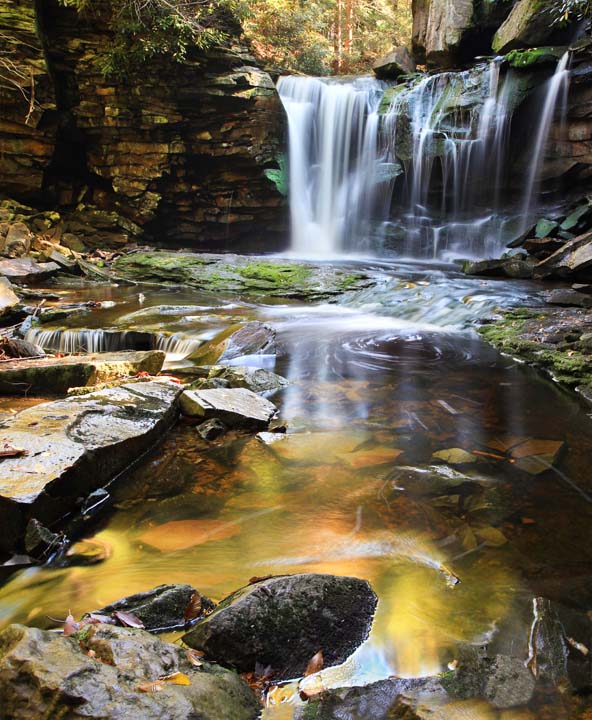
1. Blackwater Falls State Park had long been on my “must visit” list, and I particularly wanted to capture peak fall foliage color. I searched online for fall images from that area and decided that early October would be the best time, so I made reservations at the Blackwater Falls Lodge for two nights, and crossed my fingers for good weather. I was blessed with both good weather and fairly near peak foliage; I think just one more day would have been perfect. I drove from my home in Barboursville, Virginia to Dolly Sods Wilderness Area in the Allegheny Mountains of eastern West Virginia on a Thursday to photograph the fantastic color there. After sunset I drove on to the Lodge, arriving much later than intended after losing phone service in the wilderness area which eliminated any hope of smartphone GPS guidance. I was lucky to have printed directions, but unlucky in finding the Lodge dining room still available where I had one of the worst meals of my life. Early the next morning I started down the trail to Elakala Falls but soon discovered that the marked trail provided some overlook areas but no footpath down to the bottom of the falls, which of course was my destination. It was a bit of a scramble through brush and over rocks, and I must have slipped and slid more times than I care to mention. Once at the base for the first falls I sought out the best location. Of course, the best location that I saw was over some very slippery boulders coated in a very thin layer of muck and algae. But once at the location I saw that I could get the golden color of the sun-lit trees above the falls reflected in the water in front of me, as well as a small eddy formed from rotation of the foam generated by the tannin-filled waters. I would have liked to get lower as I took this shot, but lower or higher would have lost the golden reflection. I continued my hike down the canyon to successive falls, but nothing I captured beyond Elakala equaled the splendor of this falls. Technical details: Canon 5D Mark II, Canon 24-105mm f/4L IS lens at 32mm, 3.2 seconds at f/16, ISO 100; on a tripod.
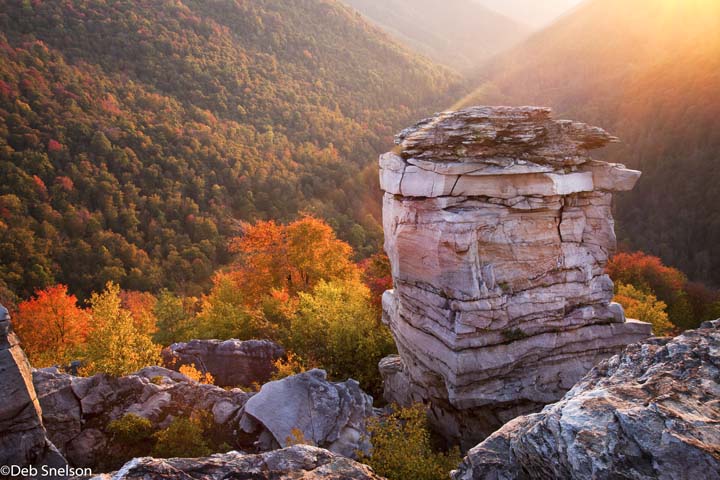
2. This photo was taken on the same October visit to Blackwater Falls State Park as image #1. I left the park late afternoon on the 7th to find some decent food after the previous evening’s disaster and visited Davis, WV, right outside the park. With the town no more than a few storefronts long, I scoured the menus of the restaurants and let my taste buds pick my favorite. Unfortunately, it wasn’t going to open until 5PM which was over an hour away, so I drove to Thomas for gasoline and passed the time browsing at an antiques place. It was well worth the wait – my “Sportsfield Kebob” dinner at Muttleys was outstanding. I raced back to the park and thought I had a little extra time so I walked to the overlook for Blackwater Falls which was in the shade but the trees in the foreground were ablaze with color. I took a few shots then I headed to Lindy point and discovered my folly – it is on a very narrow road with only a few parking spots at the end that were already filled! I managed to drive down a narrow track, clearly not intended for general traffic and quite possibly someone’s driveway, turn my vehicle around (forwarding and reversing at least 20 times….) without sliding into drainage ditches on either side, and park in a line with the other latecomers, before starting the nearly mile-long hike to the point. With hindsight, I will leave myself more time to get to this point in the future, because when I did arrive there were about 10 other photographers with tripods set up who had the exact same plans. I set up behind the hoodoo but with a view down the gorgeous orange and yellow valley. And then we all waited. We were essentially looking right into the sun which is not normally how I would choose to shoot a sunset (I prefer the objects lit up by the setting sun, rather than shooting into the sun). The sky lacked clouds which would have given detail to the sky as the sun set, and the valley was not as brightly lit as I had hoped. With the bright sun and dark-toned valley the contrast was too great between the two of them to get a good photo. But then I got lucky. I was already set up with an image in my viewfinder that excluded the boring sky. As the sun was sliding below the hillside to my right, a sun ray crossed the tip of the hoodoo! This is one of those times when I knew I had my shot while I was still in the field. Now I don’t usually recommend this, because I know that dusk produces some of the best images, but I packed up and headed out while the other photographers remained in place. I do know that there were no lights in that valley to make a great dusk photo, and that the valley was already in shadow, so my instincts told me I had what I came for. My one regret is that I don’t have a way to see what the other photographers captured. Maybe they saw the sun ray, too. Those who were to the right of the hoodoo and did not have the hoodoo in their viewfinders may have a ray pointing into the valley. Maybe I missed out on a great dusk shot. But I am happy with this photo. btw: this photo was selected by jury for an exhibit with other photographer’s photos at UVA Hospital in Charlottesville March 2 – May 4, 2012. Technical details: Canon 5D Mark II, Canon 24-105mm f/4L IS lens at 35mm, 1.0 seconds at f/20, ISO 100; on a tripod.
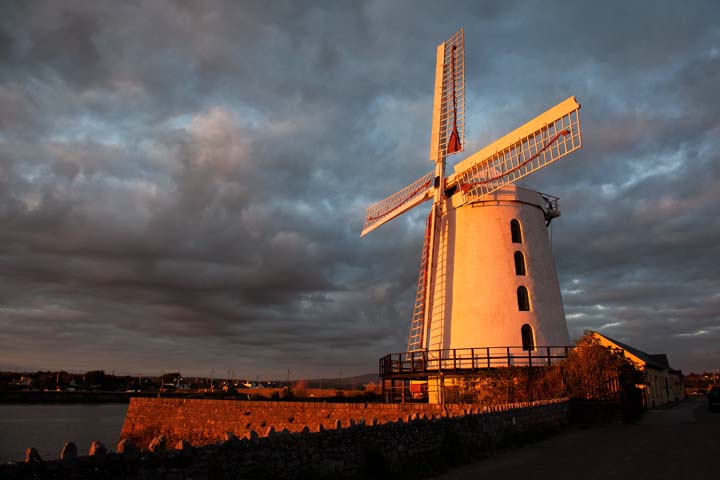
3. After a full day driving around the Dingle peninsula in County Kerry, Ireland, to photograph sites for the www.megalithicireland.com website, we were making our way back toward our bed & breakfast in Tralee when the setting sun lit up the countryside with the most amazing light. Ireland’s northerly latitude makes for long summer days so it was just past 9PM local time on July 21st and as usual we had barely a bite to eat since morning. All along the road we were looking for something that would photograph well and were so delighted to see this windmill just south of Tralee in Blennerville. The color of the setting sun made this white windmill a gorgeous golden color. We stopped and I jumped out of the car to snap this one, hand held. In addition to the drenching of sunlight, the dark gray clouds over the pale blue sky was just a perfect backdrop. Minutes before that sky had been nearly cloud-free – one of the most astounding things about Ireland is how quickly the sky changes as clouds seem to race across the sky. When you get clear weather, the quality of the light is outstanding. Technical details: Canon 5D Mark II, Canon 24-105mm f/4L IS lens at 24mm, 1/200 second at f/9.0, ISO 640, hand held
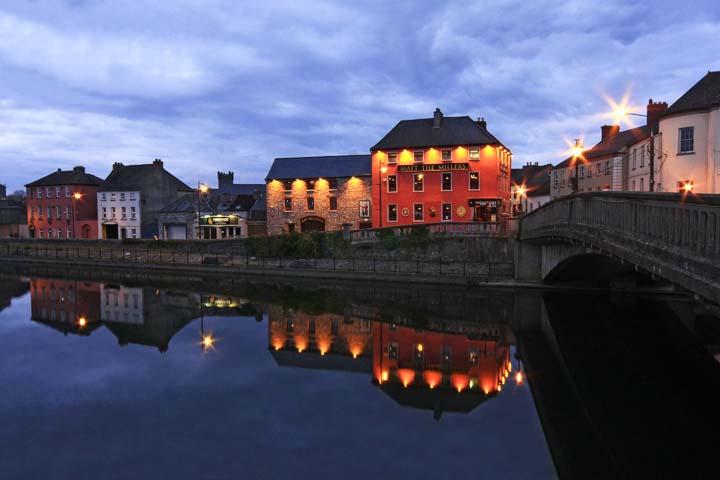
4. I almost didn’t include this photo in this list because it seemed like ages since I took it, but it is from March 2011 – hooray! Prior to my visit to Kilkenny City I spotted a photo online of this brightly-lit area along the River Noir, and I looked forward to trying my hand at a dusk shot. We walked from our lovely accommodations at River Court Hotel and tried several locations before settling on this one, and waited for the “Blue Moment”. I have a pdf on taking dusk photos under “Tutorials” on this website, so I won’t go into all the details here, but the Blue Hour is when the sky takes on a deep blue color while street lights show up splendidly, generally about a half hour after sunset (or before sunrise). I chose an f-stop of 16 for this shot to get the starburst pattern of the lights. Usually it is recommended to select an evening sky with no clouds, but I think the cloudy sky adds a textural element to this photo. Everything else can be attributed to the location with brightly colored buildings, including a fave, Matt the Miller’s Pub. This photo was a finalist in the Charlotteville Photography Initiative (CPI) 2011 Annual Photo Contest and was printed to 24×30″ and displayed in their headquarters in June. Technical details: Canon EOS 40D, Sigma 10-20mm lens at 16mm, 0.8 second at f/20, ISO 640; on a tripod.
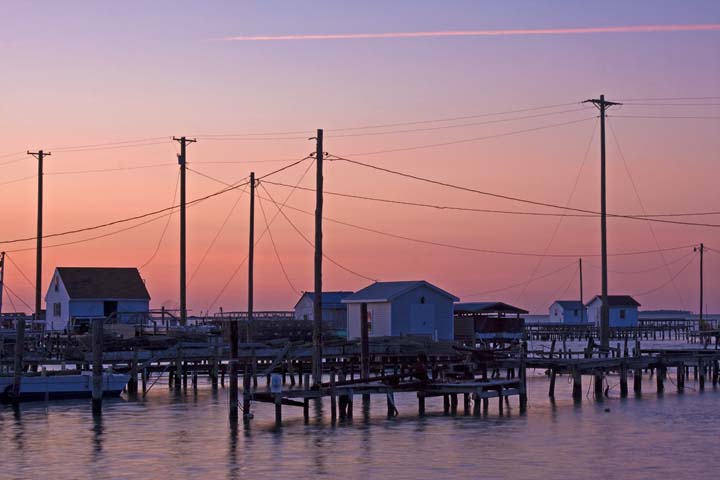
5. This is one of my favorite images, but I have yet to decide if it is a “great” image. It was taken pre-sunrise from the dock area in Tangier on Tangier Island, which sits out in the middle of the Chesapeake Bay, accessible only by boat or plane. The island is only about 1 mile wide and 3 miles long and has about 700 residents, most of whom make their living off the water. Most Tangier Island residents maintain a simpler way of life – they have no vehicles to travel about on the Island but instead rely on golf carts and bikes down narrow alleyways. Visiting Tangier Island is like stepping back in time. Today, the island is home to a close knit community, many of whom are related. The natives speak in a beautiful Elizabethan English, which denotes a true “Tangierman”. It is a beautiful place to visit. I really love the color of the sky in this; to me the lack of cloud denotes a peacefulness, although a few clouds in the sky are generally preferred. Technical details: Canon EOS 40D, Canon 24-105mm f/4L IS lens at 55mm, 0.8 second at f/14, ISO 100; on a tripod
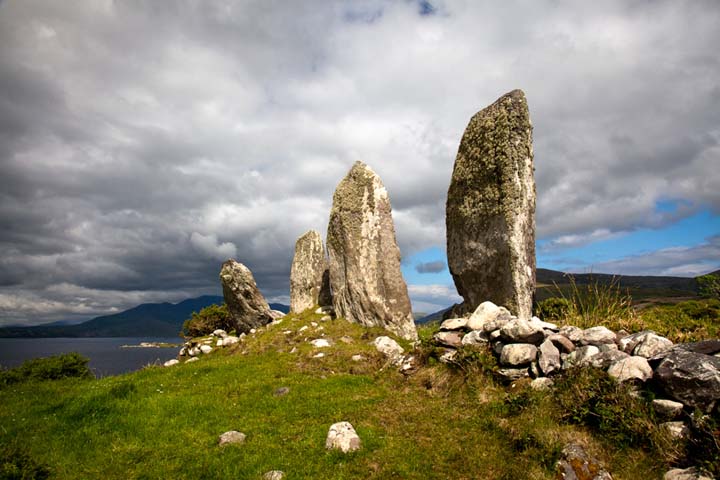
6. This is just one of many megalithic, Early Christian, and medieval fortification sites that I have visited in Ireland over the past 3 years in order to record and document sites for the www.MegalithicIreland.com website. I particularly like this photo because of the spectacular location on the Ring of Kerry, the light on the stones against the sky, and the angle of the shot. There was a cottage a short distance away to the right that I elected to exclude from the shot in order to show more of Lough Currane; in hindsight I may have preferred to include the traditional Irish gabled cottage. The sky was overcast when we entered the field with the cows (after gaining permission from the farmer) so we waited at least 40 minutes for the sun to break through the clouds and the light to hit the stones and thus create this shot. Notice how the low angle for shooting makes the stones more prominent against the sky. Technical details: Canon 5D Mark II, Canon 24-105mm f/4L IS lens at 24mm, 1/160 second at f/18.0, ISO 400, hand held.
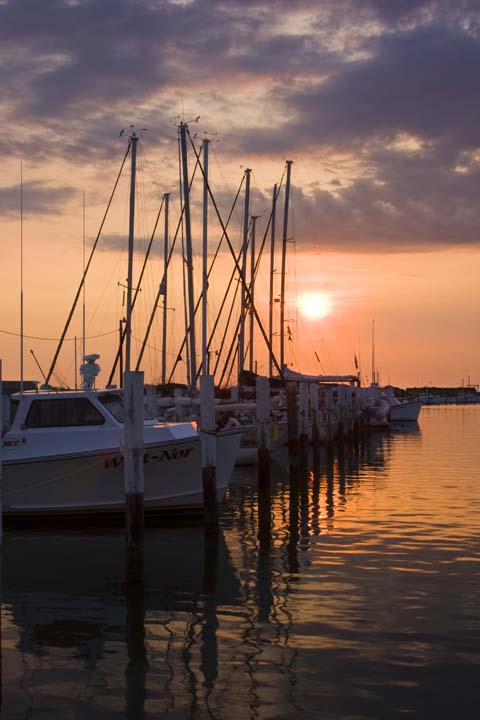
7. This photo was also taken on Tangier Island at sunset on the same day as #5. I was aiming for a composition that would stagger the boats on a diagonal with the sun setting behind the masts and those masts reflected in the water. Yet I didn’t want to put the horizon in the center of the composition, and I wanted a bit of the gray clouds of the sky for contrast. I was standing on a pier that was perpendicular to the scene, so there was no way to move forward or backward – a zoom lens is essential in a situation like this. This is a spot I’d like to re-visit to play more with the composition and hope for more colorful sunset. Technical details: Canon EOS 40D, Canon 24-105mm f/4L IS lens at 32mm, 1/15th second at f/20, ISO 100; on a tripod.
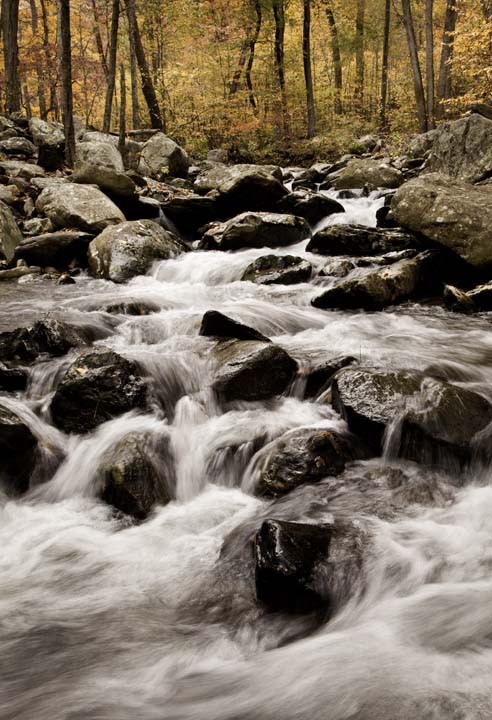
8. This image was taken on a workshop I attended lead by Ian Plant to Shenandoah National Park near Luray, Virginia. I live close to the Swift Run Gap entrance to the park so I thought this workshop would get me to a more northerly portion of the park than I usually visit. We hiked into While Oak Canyon from the bottom to the top, stopping at strategic points to take photos. My tripod was barely balanced over a boulder just at the edge of the rapidly flowing water to take this shot. I was hoping to capture the “S” shape flow of the water through the rocks. As you can see fall foliage color was just passed peak leaving mostly orange leaves. What I like most about the photo is the movement it conveys. Technical details: Canon 5D Mark II, Canon 24-105mm f/4L IS lens at 35mm, 1/5 seconds at f/20, ISO 200; on a tripod.
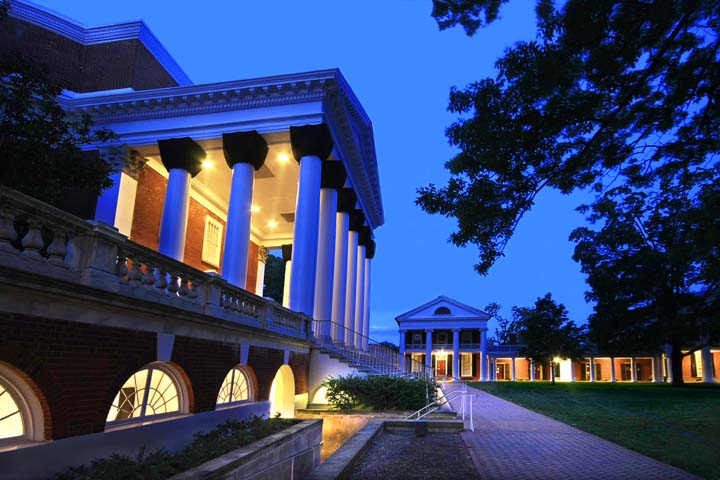
9. This dusk shot of the Lawn side of the UVA Rotunda in Charlottesville Virgnina is one of my favorites. It was a lovely early evening in May and I decided to try to capture the Rotunda for a dusk photo which was at least a 40 minute drive from my house. As I neared the Rotunda I realized that I had to find parking in one of the busiest parts of town! Believe it or not I found a spot directly across from the Rotunda and quickly scouted for a good place to set up to wait for Dusk. This location attracted me because of the strong oblique leading line of the sidewalk, and if you look closely the line of the right edge of the sidewalk continues up the stairway handrail and then back towards the viewer along the top of the palisades. After I selected my location a whole crowd of students appeared on the steps. They appeared to be high school seniors meeting there for a tour of the campus. No sooner had the students cleared out then the “blue moment” arrived. Unfortunately, when the sun set the winds began to blow. I had composed my shot with the tree leaves and with the long exposure time I found a bit of movement in the leaves, especially with the 13 second exposure!. Technical details: Canon EOS 40D, Sigma 10-22mm lens at 11mm, 13.0 seconds at f/9.0, ISO 100; on a tripod.
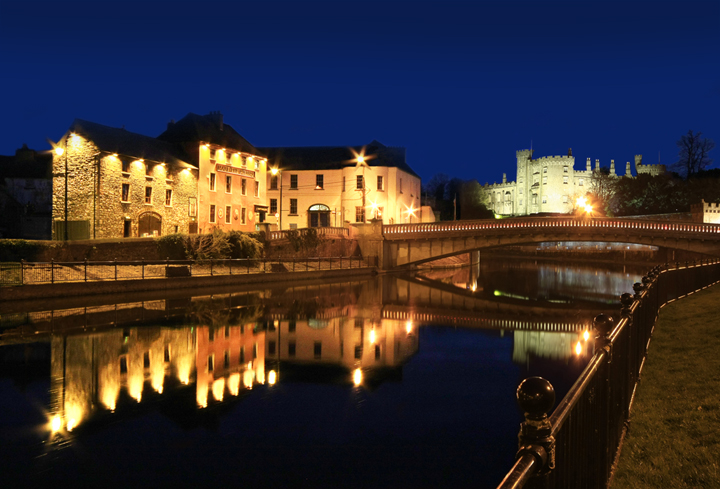
10. Another photo from Kilkenny City, Ireland on the same night that I captured #4. While the scene in #4 is definitely a “Dusk” shot – taken about 1/2 hour after the sun had set – this one was taken from my next scouted stop and by then the sky had almost lost all of the blue color. Yet the dark midnight sky and water is nicely contrasted with the yellow glow of the well-lit buildings from the lamps, and fortunately the lighting assured that details were maintained. I love the railing on the far right as a leading line into the photo. I wanted a deep depth of field with this image so I set my aperture to f/20; the length of time the shutter was open did not matter since I was on a tripod. I was really fortunate to have a vehicle cross the bridge from one side to the other while the shutter was open, creating that line of light that pops out the bridge. And, of course, there is a near perfect reflection in the river. Technical details: Canon EOS 40D, Sigma 10-22mm lens at 18mm, 2.0 seconds at f/20, ISO 640; on a tripod.
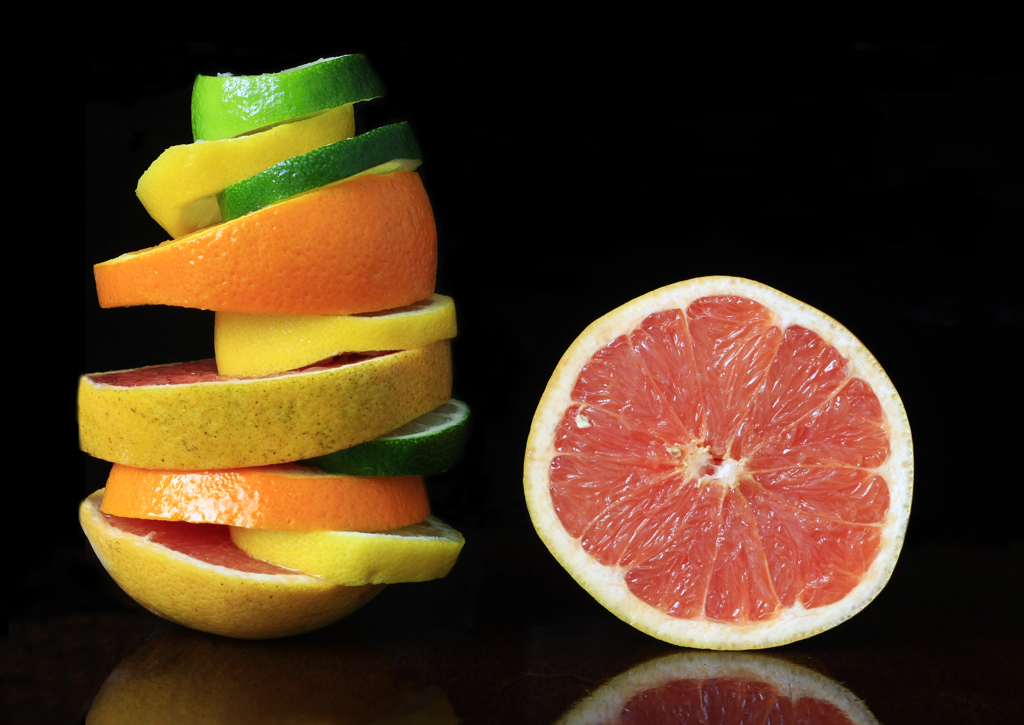
11. This photo was created for a “Shoot Off” contest for the Charlottesville Photography Initiative. Contest participants were given a subject at 10AM, and had to shoot, edit and upload photos by 5PM. The subject for this contest was Juxtaposition, so I created this image to juxtapose different shapes and colors. It was a lot of fun to compose and I learned a bit about getting round things to stay stationary lol. I used natural light from a window, and set the fruit on a piece of polished wood. I love the bright colors!
Technical details: Canon EOS 40D, Canon 50mm f/2.8 lens at 50mm, 1.6 seconds at f/11, ISO 100; on a tripod.
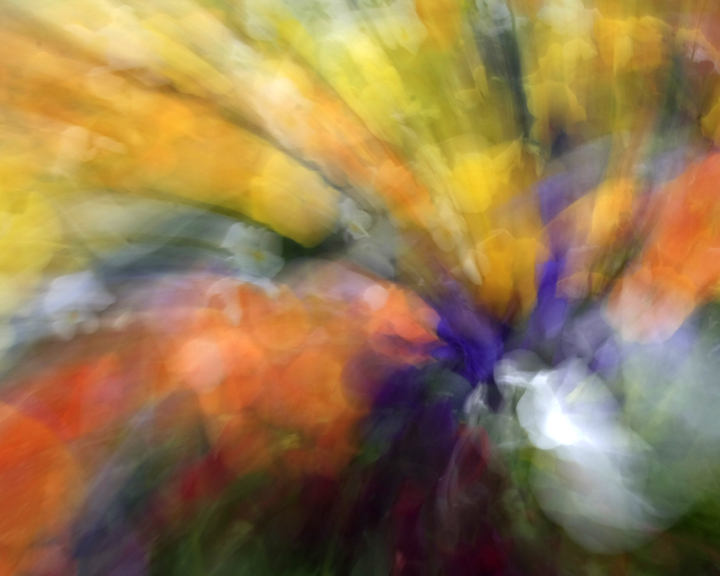
12. Last but not least is this abstract photo that I created by spinning my camera one direction with one hand, while spinning the lens the opposite direction with the other hand, and pressing the shutter, all while hand holding. The difficult part was keeping the center point. The hand turning the camera itself would usually move off my center point. I am sure there is a better way to do this, perhaps with the lens mounted on a tripod. But I did get lucky with this one after about 20 tries, and liked what I saw on the LCD before I left the nursery (the subject was a pot of pansies in the colors seen here). I cropped this image to place the center point on or near the lower right “rule of thirds” grid line crossing. I was honored to have this photo selected as “Best Creative Print” for 2011 in the annual photography contest of the Charlottesville Camera Club. Technical details: Canon EOS 40D, Canon 24-105mm f/4L IS lens at 24mm, 0.8 seconds at f/22, ISO 100; hand held.
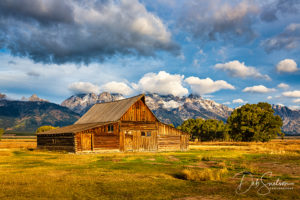
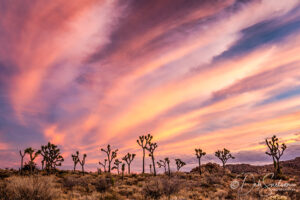

Laila Zekiros
15 Mar 2012Stunning! Congratulations on 2 and 12! 🙂